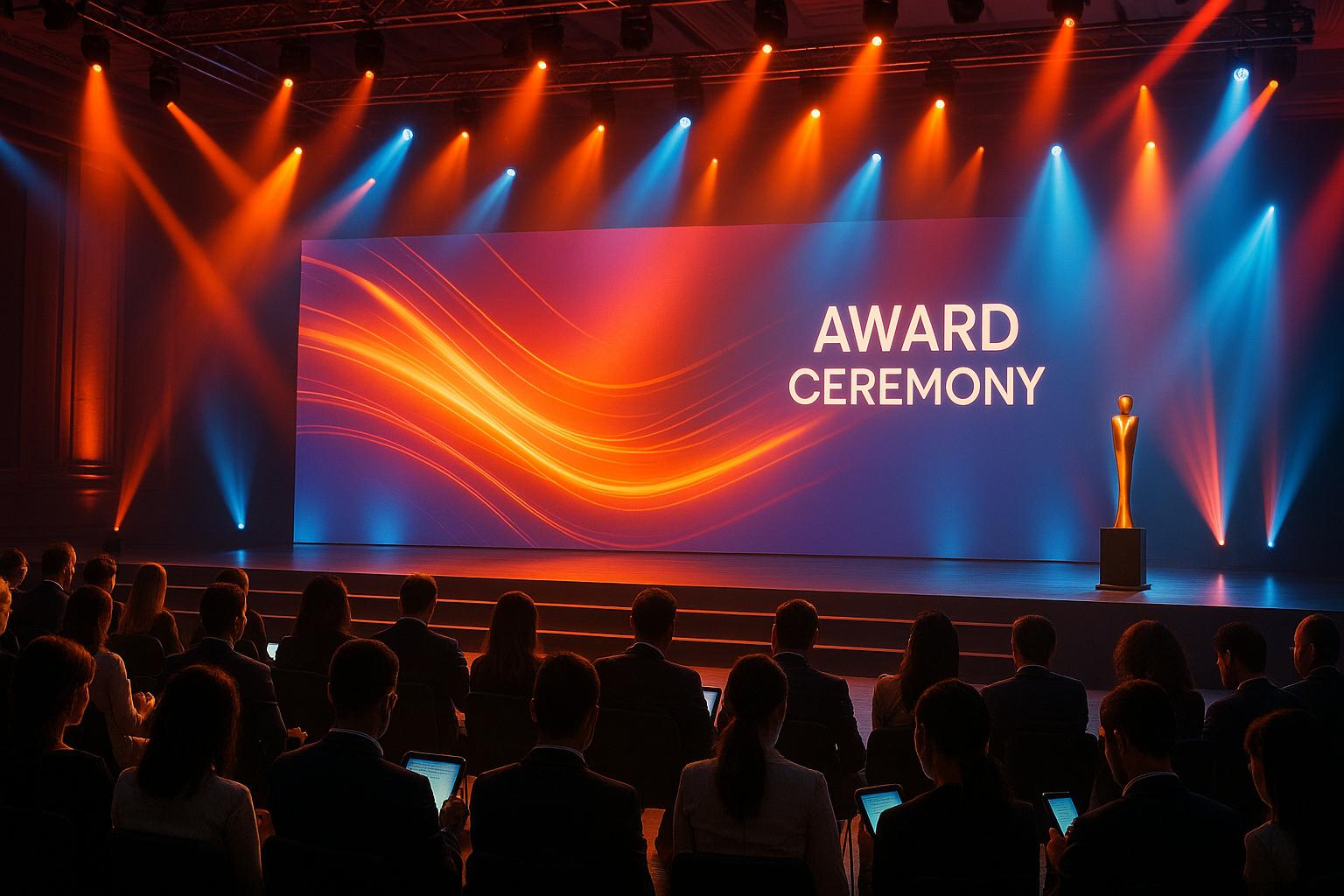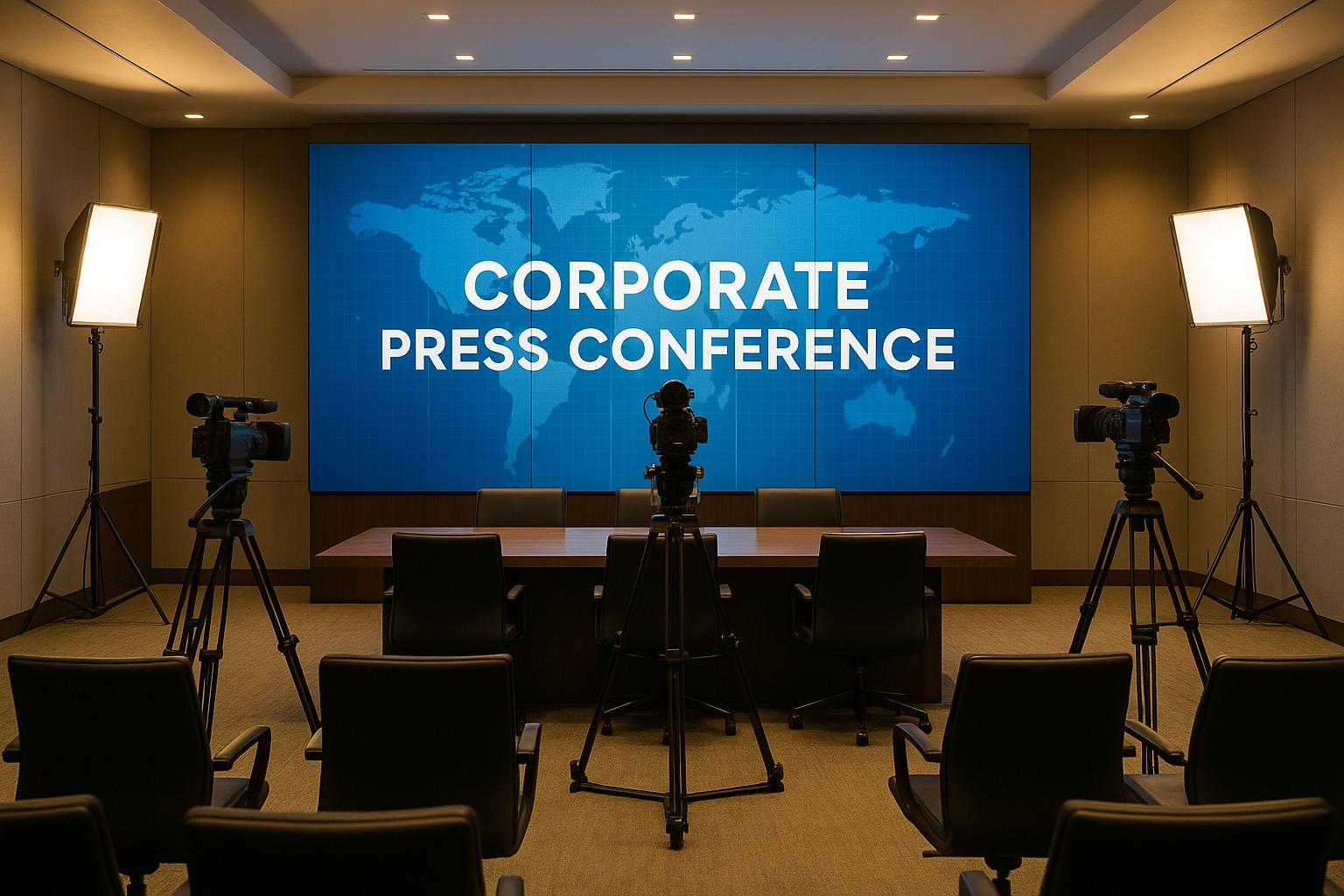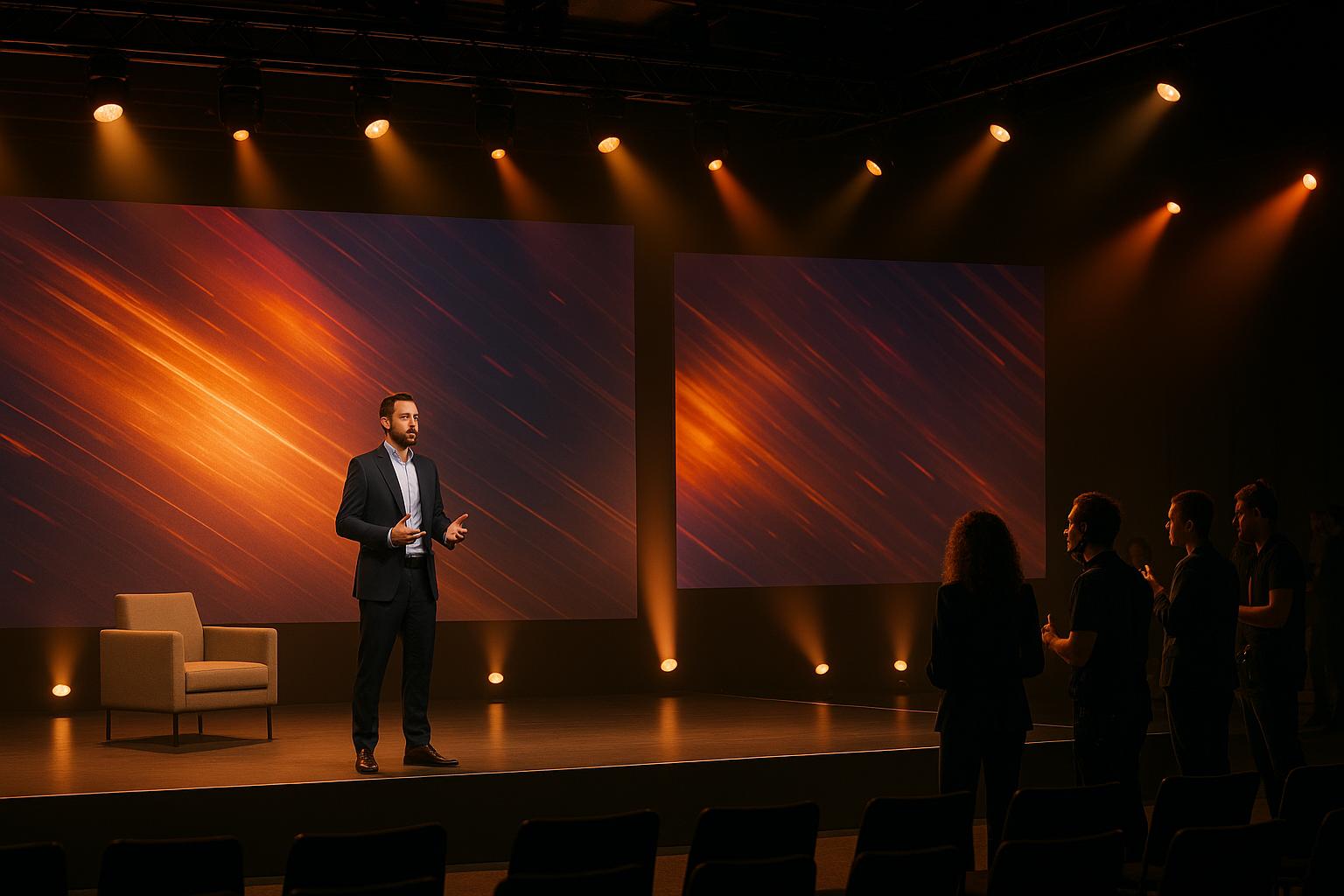Three Trends In Award Ceremony Production You Should Consider

Chief Executive Officer

- Advanced Audiovisual Techniques: Tools like LED walls, projection mapping, and robotic cameras create visually stunning environments that keep audiences engaged. These technologies also ensure high-quality experiences for hybrid and virtual viewers.
- Audience Engagement Strategies: Interactive tools such as live polls, gamification platforms, and virtual photo booths turn passive viewers into active participants. These features boost interaction and create memorable moments for attendees.
- Hybrid and Virtual Integration: Combining in-person and remote elements allows events to reach global audiences. Features like real-time voting, virtual networking lounges, and accessibility tools ensure everyone feels connected.
These trends require careful planning and investment but deliver impactful results by enhancing participation, improving production quality, and expanding audience reach.
Virtual Awards Celebrations – Ideas and Best Practices
1. Advanced Audiovisual Techniques
Award ceremonies today are embracing cutting-edge audiovisual technologies to create captivating and immersive environments. Tools like LED walls, projection mapping, and intelligent lighting systems bring dynamic visuals to life, adapting seamlessly to the flow of the event in real-time.
Visual and Technical Appeal
LED technology has completely transformed stage design for corporate award events. Gone are the days of static backdrops; LED walls now provide vibrant, customizable visuals that can change in seconds. With 4K resolution and smooth integration, these displays create depth and movement, keeping audiences engaged throughout even the longest ceremonies.
Projection mapping elevates visual storytelling by turning ordinary surfaces into animated masterpieces. This technique projects custom graphics onto three-dimensional objects, creating the illusion of movement or transformation. From stage floors and podiums to entire venue walls, projection mapping adds a layer of magic to award ceremony settings.
Intelligent lighting systems play a key role in setting the mood. These systems can adjust color, brightness, and direction based on pre-programmed sequences or real-time controls. Whether it’s building anticipation during nominations or creating an intimate atmosphere for acceptance speeches, lighting enhances the emotional arc of the event.
Meanwhile, robotic camera systems ensure professional, high-quality coverage without the need for a large crew. These automated cameras glide along pre-planned paths, capturing cinematic angles effortlessly. The result? Consistent, polished footage that would traditionally require multiple operators.
These advancements not only enhance the live experience but also ensure smooth delivery across hybrid and virtual platforms.
Scalability and Accessibility for Hybrid/Virtual Formats
Modern audiovisual technologies are designed to cater to diverse formats - whether in-person, livestreamed, or recorded for later playback. To achieve this, careful attention is given to elements like lighting, camera placement, and audio mixing to ensure the production shines on all platforms.
Audio enhancement technologies now deliver crystal-clear sound for both live and virtual audiences. Directional audio processing ensures in-room attendees enjoy balanced acoustics, while separate audio feeds are optimized for streaming, providing a seamless experience for remote viewers.
Real-time graphics integration has become a game-changer for live broadcasts. Producers can overlay digital elements like winner names, sponsor logos, or social media updates without disrupting the ceremony. These graphics appear instantly on streaming platforms while remaining invisible to the in-person audience, tailoring the experience for each group.
Multi-camera switching technology keeps the visuals dynamic, smoothly transitioning between wide shots, close-ups, and audience reactions. Advanced systems can even automate these transitions using audio cues or pre-set sequences, ensuring every key moment is captured, no matter the viewing format.
Together, these technical advancements elevate award ceremonies to new heights, delivering a polished and engaging experience for all types of audiences.
2. Audience Engagement Strategies
Award ceremonies are evolving from traditional, sit-back-and-watch events into lively, interactive experiences that actively draw attendees into the action. This shift makes audience engagement a key focus in planning and execution.
Audience Participation and Inclusivity
Interactive tools are now indispensable for keeping audiences engaged in real time. Platforms like Poll Everywhere allow attendees to participate in live polls and Q&A sessions using their smartphones. Similarly, Slido offers features like live polls, word clouds, quizzes, and ranking systems that integrate effortlessly into presentations. Another standout is Mentimeter, which enhances participation and fosters a sense of inclusion, especially in corporate settings.
Adding a layer of fun, gamification is proving to be a game-changer. Platforms such as Captello and Kahoot! provide customizable interactive games, complete with leaderboards and quizzes that can spotlight anything from award nominees to company trivia. These elements not only entertain but also create a sense of connection and excitement among attendees.
Visual and Technical Appeal
Memorable visuals and tech-driven moments can leave a lasting impression. For instance, Snapbar offers virtual photo booths and creates event-branded digital collages, enabling both in-person and virtual attendees to share in a unified photo experience. These digital keepsakes often find their way onto social media, expanding the event’s reach.
Keeping the energy alive during the ceremony is another priority. Tools like StreamAlive transform live chat comments into dynamic word clouds that reflect audience sentiment in real time. Meanwhile, interactive storytelling platforms such as Twine let presenters craft narratives shaped by audience votes, making the experience feel more personal and engaging. Together, these tools ensure ceremonies are visually stimulating and interactive.
Scalability and Accessibility for Hybrid/Virtual Formats
For events that cater to both in-person and virtual audiences, seamless integration of interactive tools is essential. The Cvent Attendee Hub combines live chat, polling, Q&A, and networking features into a unified platform, ensuring balanced participation across all attendees.
Additionally, tools like Crowd Mics and Catchbox make live Q&A sessions more accessible by turning smartphones into microphones. These solutions also offer digital alternatives for those who might not feel comfortable speaking up, ensuring everyone has a voice.
The secret to effective audience engagement lies in layering these techniques - polling, gamification, social sharing, and more - throughout the event. By doing so, producers can keep audiences of all types actively involved, no matter their preferences or technical setup.
sbb-itb-ae35a94
3. Hybrid and Virtual Event Integration
The rise of hybrid and virtual award ceremonies has reshaped how event producers design and execute their plans. These formats require a fresh approach to captivate both in-person and remote audiences. This shift builds on earlier advancements in audiovisual technology and audience engagement strategies.
Visual and Technical Appeal
Creating a visually compelling experience is essential for hybrid ceremonies, as visuals must resonate with both live and virtual viewers.
Features like LED walls and digital backdrops not only enhance the physical venue but also deliver high-quality visuals for remote attendees. These displays can showcase sponsor messages, nominee highlights, and real-time social media feeds, ensuring both audiences stay connected and engaged.
Technical reliability is equally important. Stable, high-speed internet connections and built-in redundancies are critical to maintaining smooth hybrid streaming. Beyond the visuals, interactive elements are key to keeping remote participants actively involved.
Audience Participation and Inclusivity
Engaging virtual audiences requires thoughtful strategies to ensure inclusivity and interaction. For example, real-time voting systems let remote viewers participate in categories like audience choice awards, creating shared moments of excitement with in-person attendees.
To replicate the networking opportunities of live events, virtual networking lounges can be introduced. These digital spaces allow remote participants to connect during breaks, fostering meaningful interactions similar to those formed at in-person gatherings.
Dedicated virtual hosts are another way to keep online audiences engaged. These hosts interact directly with remote viewers by reading comments, facilitating discussions, and ensuring they feel acknowledged throughout the event.
Scalability and Accessibility for Hybrid/Virtual Formats
Hybrid ceremonies break through traditional venue limitations, allowing events to reach a global audience.
Pre-recorded sessions and region-specific highlights can make the event more accessible across different time zones, sometimes with the addition of regional hosts to cater to specific audiences.
Accessibility features are also easier to implement in hybrid formats. Tools like closed captioning, sign language interpretation, and audio descriptions can be seamlessly included in virtual streams, benefiting both online and in-person participants.
While hybrid events often require larger production teams to handle the added complexity, the ability to reach a broader, international audience and offer improved accessibility often makes the investment worthwhile for organizations with diverse or global audiences.
Comparison Table
Here’s a breakdown of the key benefits, challenges, cost factors, and production needs for each trend:
| Trend | Key Advantages | Key Challenges | Budget Considerations | Production Considerations |
|---|---|---|---|---|
| Advanced Audiovisual Techniques | Boosts visual appeal and highlights sponsor presence | Requires specialized tools and skilled technicians | Demands a higher financial commitment | Needs precise coordination on-site and experienced crews |
| Audience Engagement Strategies | Encourages live interaction and amplifies social media reach | Learning to use interactive platforms can be tricky | Offers a budget-friendly way to enhance engagement | Fits seamlessly into existing timelines |
| Hybrid and Virtual Integration | Broadens audience access and improves inclusivity | Balancing in-person and virtual elements can be complex | Provides value by reaching a larger audience | Involves rigorous testing of both physical and virtual setups |
Each trend comes with its own set of technical and logistical needs. For instance, advanced audiovisual setups rely on dedicated teams and backup plans, while hybrid events require expertise in both in-person and virtual environments.
When it comes to budgeting, the costs vary significantly. Advanced audiovisual techniques often require a larger investment, audience engagement strategies are typically more economical, and hybrid events offer extended reach, making them a worthwhile consideration. Production timelines also differ - advanced setups need more on-site preparation, hybrid events demand thorough technical testing, and engagement tools are usually simpler to integrate.
Don’t forget accessibility! Features like automated captions and adjustable audio settings are essential for ensuring ADA compliance.
Conclusion
The three trends shaping the future of award ceremonies - advanced audiovisual techniques, audience engagement strategies, and hybrid and virtual integration - offer exciting opportunities for event planners. By adopting these innovations, you can deliver unforgettable experiences while broadening your event’s reach and influence.
Start by assessing your resources and production capabilities to determine which trend aligns best with your goals. If your budget is tight, focusing on audience engagement strategies can provide impactful results without overspending. For events with larger budgets or higher sponsor expectations, investing in advanced audiovisual techniques can elevate the ceremony into something truly spectacular.
Meanwhile, hybrid and virtual integration is essential for organizations aiming to boost attendance and ensure inclusivity. This approach not only increases accessibility but also preserves the prestige of the event, making it a win-win for attendees and organizers alike.
Pulling off these trends successfully requires expertise and careful planning. Award ceremonies today demand professionals who can balance creative vision with the practicalities of execution. Partnering with experienced providers ensures that your event runs smoothly while incorporating the latest trends seamlessly.
Corporate Optics specializes in technical event production and AV solutions, offering the expertise needed to bring these trends to life. Their ability to integrate cutting-edge technology, including AI-powered solutions, ensures your ceremony meets the highest industry standards while delivering an exceptional experience for your audience.
When executed with precision, these strategies can redefine your award ceremonies, enhancing sponsor relationships, engaging audiences, and strengthening your brand image. As the landscape of award ceremonies continues to evolve, staying ahead of these trends will set your events apart in a competitive market.
FAQs
How do advanced audiovisual techniques improve the experience for both in-person and virtual award ceremony attendees?
Advanced audiovisual techniques can transform an event into an unforgettable experience for both in-person and virtual attendees. For those attending in person, top-notch sound systems and well-planned lighting play a key role in ensuring every speech, announcement, and stage moment is both clear and visually striking.
For virtual participants, features like live streaming and interactive elements help bridge the gap, making them feel like part of the action, no matter their location. Adding dynamic visuals - such as nominee highlight reels, animated graphics, or customized winner slides - keeps the energy high and the audience engaged. Small but thoughtful details, like background music or tailored visual effects, can elevate the event’s atmosphere, leaving a polished and professional impression on everyone involved.
What are some effective ways to make an award ceremony more interactive and engaging for the audience?
To make an award ceremony more engaging and interactive, incorporating mobile apps, live polling, and social media integration can work wonders. Mobile apps provide attendees with real-time updates and offer features like voting or Q&A sessions, keeping everyone involved. Live polling adds an element of excitement by inviting the audience to share their opinions during the event. Meanwhile, integrating social media allows attendees to livestream moments, share experiences, and connect with others online.
Adding interactive technology such as touchscreens or video walls can elevate the experience even further. These tools can display dynamic content, spotlight winners, or showcase audience participation, turning the event into something truly memorable. Together, these elements create an immersive atmosphere that keeps attendees engaged from start to finish.
How can I effectively incorporate hybrid and virtual elements into an award ceremony to increase inclusivity and global reach?
To bring hybrid and virtual elements into an award ceremony successfully, focus on three key aspects: accessibility, engagement, and quality. Start by making the event inclusive - ensure remote participants can join effortlessly without the need for travel. Features like live Q&A sessions, real-time polls, and virtual games are great tools to keep everyone involved and connected, whether they're attending in person or online.
For a polished experience, prioritize high-quality production. Combine live moments with pre-recorded segments and use cutting-edge audiovisual techniques to create a seamless flow. Adding custom branding and visuals to the virtual environment can elevate the event, leaving a lasting impression of professionalism and creativity. Lastly, selecting a reliable virtual event platform with strong features and dependable technical support is crucial. This ensures everything runs smoothly for both in-person attendees and those tuning in remotely.
Related Blog Posts









